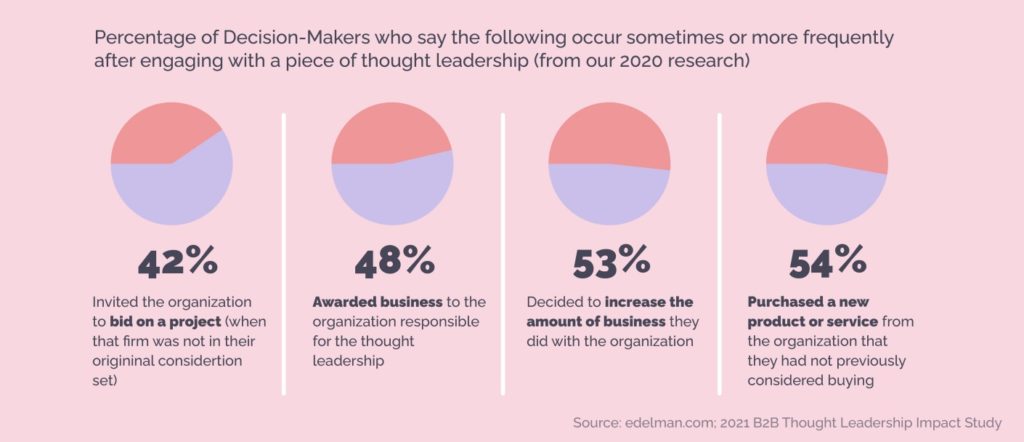Trust is everything in the B2B space.
Yet as recent research from Forrester has shown, there’s a significant gap between how much brands believe customers trust them and how much customers actually do trust them.
Bridging this gap is imperative, but how? It’s one thing to approach trust as a holistic imperative; it’s another to practice a set of concrete actions that actively build trust with clients.
In this blog post, we’ll offer four practical actions B2B marketers can take to nurture trust with their prospects and customers. Let’s get started!
1. Make product/service information, pricing, and full contact information available on your website
When we said practical, we meant practical!
According to a survey from CustomerThink on B2B web usability, the top two categories of website information that were most crucial to customer trust were product/service information and contact information.
If a prospect is interested in your product, but they have to fill out a form or contact a salesperson in order to get all the information they need—for instance, pricing or specs—there’s a good chance they’ll feel like they’re being baited into a sales pitch. And that’s the last thing today’s customers want.
With services, especially those that are customized to individual clients, it’s more difficult to provide things like exact pricing, etc. In these cases, make sure you have full information about each service you provide. Testimonials and case studies can be useful as supporting information here.
Make it easy for prospects to find whatever they need to feel good about taking the next step. That’s the thing: If a prospect is on the fence about what you’re selling, withholding information isn’t going to bring them in. It’s going to push them away.
Next, contact information: Do you have leadership bios visible on your site? A phone number, physical address, and email address? This information adds transparency, which is a critical aspect of B2B trust.
Next steps: Review your website and add information where needed. For leadership, consider adding social profiles, photos, bios, and other relevant info, and make sure your business’s address and phone number are listed as well as its email addresses.
Related post: Building Trust in the B2B Space: An Interview with Stephanie Chavez, Zen Media’s Global Chief Marketing Officer
2. Conduct original research
Conducting and publishing original research is another highly effective way to increase trust in your organization.
The data bears this out: according to MarketingProfs, 74% of B2B buyers consider original research to be influential in their purchasing decisions. However, just 37% of B2Bs include research in their content marketing (that’s from original research by the Content Marketing Institute).
Original research gives B2B prospects confidence that your brand is an expert in your industry—and not just because of anecdotal experience or the collective knowledge of your team, though those are both important. Prospects want to see that you can prove your claims with data.
Not all research has to be exhaustive, expensive, and performed by a third-party market research firm. If you have the budget, by all means, go for it, but most B2Bs will want to start smaller.
Try surveying your customers about what marketing tactics they think have been the most effective. Run long-term A/B testing on your emails to see what tactics are spurring the most email opens or clicks, and package the findings in a well-designed report.
Then, you can offer these as gated content on your website and create digital marketing campaigns to promote them.
Next steps: Your brand likely has plenty of data already, but it is probably siloed in different platforms and departments. Begin your research initiatives by choosing a data set you want to examine and looking at what you can learn from it.
3. Put your brand values front and center
The Harvard Business Review found that shared values are important to 64% of customers when it comes to creating a relationship with a brand.
If you haven’t taken the time to explicitly clarify what your brand stands for, schedule time for it now. Once you’ve gotten those values nailed down, put them on your website, social profiles, and include them in your job listings.
Since these values should be an organic element of your brand, they will hopefully be evident already in your content marketing and social media presence. However, most brands can stand to do a quick audit of their content to make sure that it matches the values the company is professing.
Plus, establishing an explicit set of values can also be a great prompt for content creation, campaign ideation, and brand initiatives.
Next steps: Brainstorm with your leadership team to explicitly outline your values; if this has already been done, make sure your values are listed clearly on your website and in your company’s social profiles.
4. Start a thought leadership initiative
Thought leadership is a non-negotiable for B2Bs that want to become frontrunners in their industry.

Research by Edelman and LinkedIn found that thought leadership can not only establish a brand as an expert but actually directly and quickly influence purchase decisions: 54% of decision-makers said they made a purchase from a brand they had not previously considered after engaging with a piece of B2B thought leadership.
You can start your thought leadership initiatives by posting owned content—on your blog, your social profiles, etc.—before moving into earned and shared.
Related Reading: Why Your C-Suite Should Be Thought Leaders
A strong PR campaign can assist your brand in getting your thought leader (or leaders) attention in industry journals and major press, monthly columns on other industry sites, and potential partnerships with industry influencers.
Next steps: Identify a leader in your company who qualifies as a thought leader. This should be someone who’s both an expert in their field and has innovative, relevant, informed, and potentially disruptive ideas about your industry and its future.
Start by working with that person to write a longer blog post or column at least once monthly. You can then break up that longer content into shorter social posts, videos, and other formats.
A business that has an amazing product but low customer trust will never flourish. Building trust with your customers, before they even become customers, is essential. Put these steps into practice, and if you need help, our team can get you started right away.







